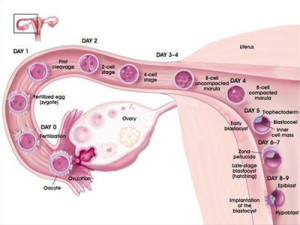What is a frozen embryo transfer (FET) cycle and when can I do an FET cycle?
When you have frozen embryos and you wish to use them, you can do a frozen embryo transfer (FET). This can happen after you have delivered your first baby and you can also use this method if you were unsuccessful with an stimulated IVF cycle.

Are there any benefits with FET over a fresh (stimulated) cycle?
The advantage of an FET over a fresh stimulated cycle is lower cost, less complex treatment (e.g. no surgical retrieval of eggs), less medication and on the whole similar success rates.
What are the success rates for FETs?
It is similar to that of an fresh IVF cycle.
What is a typical timeline?
From the time a patient visits our clinic and wishes to begin a frozen cycle, then her records would be reviewed by our team and to ensure that her pre-screening is up-to-date. But not limited to infectious disease blood-work, Pap Smear, an updated mock ET and injection review. A follow-up visit with the physician will also be scheduled.
Patients are instructed to begin with a series of injections of estrogen to build up the uterine lining. Patients are instructed to add in progesterone after a lining check upon demonstration of a thickened endometrium. The date is fixed for the embryo transfer and the patient is ready to present herself for the actual frozen transfer. The estrogen and progesterone are continued during the frozen transfer and through the blood and the pregnancy test, about two weeks later.
Is there any special pretesting or planning needed?
There is a little pretesting required however, you have had delivered or any other medical indication recently, then an Mock Embryo Transfer is carried out (Mock ET or uterine sounding). That would accurately determine and map the uterine contours. Before the actual frozen cycle most patients will be on a cycle/month of oral contraceptives.
Do I need to do consents and/or blood-work?
Yes it is important to do consents and blood-work, for this frozen treatment cycle at least every 90 days, which need to be signed by both partner and patient. It is also important that periodic infectious disease, blood work for patient and partner is needed within the previous year.
How many monitoring appointments are needed, on average?
On an average patient can have up to 4 appointments, during her cycle, one for the the baseline evaluation ( which is blood and US), this done before the medications are started, one for mid-cycle (lining check) to ensure that the uterine lining is thickened and one which is the actual transfer appointment itself and the last appointment for the beta HCG pregnancy test which is two weeks later.
Are the medicines similar to an IVF cycle?
The medications required are supplemental, which is estrogen and progesterone, which could be similar to that of an IVF cycle, yet not eh same, as daily injections that are used to stimulate the ovaries are not required. It is noted that estrogen is given once in three days in the form of an injection and progesterone is given also in the form of an injection every day as instructed after the mid-lining sonogram check is completed.